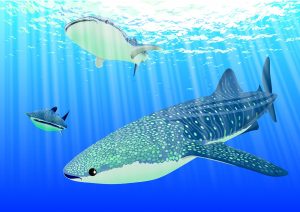 The shark or dogfish is the name commonly given to fish with a cartilaginous skeleton and a hydrodynamic body, belonging to the superorder Selachimorpha. This type of animal is feared by everyone and has over 300 species.
The shark or dogfish is the name commonly given to fish with a cartilaginous skeleton and a hydrodynamic body, belonging to the superorder Selachimorpha. This type of animal is feared by everyone and has over 300 species.
Sharks have been known to have been alive on planet Earth for many years, roughly 400 million years. And yet they manage to surprise researchers. Three species of shark that live in the twilight depths of the ocean are bioluminescent at all times.
The kiefin shark, the black-bellied lantern shark and the southern lantern shark have been found to have a soft glowing blue pattern on their skin. This is a first for sharks that are found in New Zealand.
Sharks
Of these three animals, the kitefin shark, which grows to 180 centimeters in length, is now the largest bioluminescent shark known in the world. Bioluminescence is not an uncommon thing in the evolution of living things. Even humans glow, even if it’s too dim to actually be seen.
This ability seems to be most useful for living beings that live in the dark and deep in the ocean. Places so deep that the sun’s rays cannot penetrate the water.
In a place called the mesopelagic, or twilight zone, which is between 200 and a thousand meters below the surface, bioluminescence is practically a way of life. It is believed that over 90% of all animals in this region of the ocean have some form of bioluminescence that is used in different ways.
However, in sharks this bioluminescence is not documented. And not very studied. Because of this, marine biologists Jérôme Mallefet and Laurent Duchatelet, from the Catholic University of Louvain, in Belgium, are working to change this scenario.
“Bioluminescence has often been seen as a spectacular but unusual event at sea. But considering the vastness of the deep sea and the occurrence of luminous organisms in this zone, it is now increasingly obvious that the production of light at depth must play an important role in structuring the largest ecosystem on our planet”, the researchers wrote.
Bioluminescence
The two marine biologists teamed up with Darren Stevens of New Zealand’s National Institute for Water and Atmospheric Research (NIWA) to conduct a study of mesopelagic sharks that have been found in local waters.
Because of the work done by them, it is known that the kitefin shark is in fact bioluminescent. Before this study, scientists only suspected this fact, since the 1980s.
To make these observations, scientists captured species with a trawl in January 2020. Among the hundreds of sharks captured were 13 kitefin sharks, seven blackbellies and four southern lantern sharks. All of them were used for the study about bioluminescence.
Scientists found in the skin of the three photophores, which is a light-emitting organ seen in bioluminescent animals. In sharks, this light emission is hormonally controlled. Which makes them the only species where this is seen.
Comments
The researchers found that, in all three shark species, melatonin activates the glow. The alpha-melanocyte stimulates this glow, and adrenocorticotropic hormones turn it off.
Even knowing all this, why sharks glow is not an easy thing to determine. After all, mesopelegic animals can shine for several reasons. Whether to attract a partner, attract prey, educate or camouflage.
However, scientists think the sharks’ glow may be for their camouflage. Also because the glow is concentrated around their belly and at the bottom. This can make them invisible from certain angles.
“This first experimental study of three luminous New Zealand shark species provides insight into the diversity of shark bioluminescence and highlights the need for more research to help understand these unusual deep-sea dwellers: the glowing sharks,” concluded the researchers.
